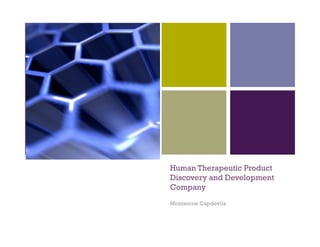
The Business Of Science
- 1. + Human Therapeutic Product Discovery and Development Company Montserrat Capdevila
- 2. + What is the Business Model? Discovery of therapeutics products that will treat, cure or prevent a particular disease or illness. Focus on scientific discovery and innovation to advance the practice of medicine. Same premise as pharma but using bio-molecular techniques. Initial IP is usually spin-out from academic or federal research. ( or other small biotech companies) Licensed Or self developed ( rights of to the technology are given back to lead scientist)
- 3. + MedImmune 1988-89: Founded in by Wayne T. Hockmeyer as Molecular Vaccines Inc. Technology spin-out from Walter Reed Army Institute of Research (?). Main technology: Production of antibodies using DNA recombinant technologies. 1990: Name changed to MedImmune. 1991: MedImmune completes its initial public offering: 2,875,000 shares of common stock at $9.25 per resulting in net proceeds of $23,987,000 in proceeds to the company. 1992: David Mott joins Medimmune as VP of Business Development. ( Main success point)
- 4. + Medimmune 1993: Acquired rights for distribution of CytoGam (Cytomegalovirus Immune Globulin Intravenous (human)) from Connaught Laboratories and becomes the sole distributor of the product. 1995: RespiGam (respiratory syncytial virus immune globulin intravenous (Human) (RSV-IGIV). A sterile liquid immunoglobulin G containing neutralizing antibody to Respiratory Syncytial Virus (RSV). Approved by FDA in 1995. 1995: MedImmune acquires exclusive worldwide rights to human papillomavirus technology developed at the University of Rochester.
- 5. + Medimmune 1997: Medimmune forms with GlaxoSmithKline (formerly SmithKline Beecham) a worldwide human papillomavirus vaccine alliance. 1998: Receive FDA approval for Synagis A monoclonal antibody produced by recombinant DNA technology used in the prevention of Respiratory Syncytial Virus ( RSV) infections. Medimmune has three products in the market. 2000: David Mott becomes CEO
- 6. + Medimmune 2003: FDA approves FluMist® (Influenza Virus Vaccine Live, Intranasal), the first influenza vaccine delivered as a nasal mist available in the United States for healthy people. 2004: MedImmune has 4 products on the market Synagis is their biggest seller ( $1.06 billion in revenue in 2005) 2007: AstraZeneca acquires MedImmune drug development pipeline for $15.2 billion. 2008: David Mott leaves MedImmune and Becomes a General Partner in NEA.
- 7. + MedImmune: Strengths & Weaknesses Weaknesses: Unproven CEO (????) First four products failed Strengths: Good management team: David Mott Founder did not wear so many hats Clear technology focus Very good at raising capital Excellent project management
- 8. + Panacea Founded in 1999 by a father and a son. Hossein A. Ghanbari, PhD Chairman, CEO & Chief Scientific Officer Diagnostics and Therapeutics Focused on targeting Cancer and CNS disorders. 2000: Series A financing 2002: Named Maryland Incubator Company of the Year 2002: Series B financing $3 Million 2002: Panacea Pharmaceuticals, Inc. and MedImmune Sign Collaboration and License Agreement to Discover, Develop, and Commercialize Cancer Therapeutics. Exclusive, worldwide agreement covers development of drugs using Panacea's HAAH Oncology Technology
- 9. + Panacea 2003:Signs License Agreement with Massachusetts General Hospital/Harvard University for SF-25 Oncology Program 2004:Collaboration with Walter Reed Army Institute of Research for Pre-Clinical Studies on Drug Candidates for Stroke and Other Neurodegenerative Conditions. 2005: Raises $7 Million in Series C Round of Financing 2006: New President & Chief Operating Officer ( Stephen Keith MD). Raises $8.9 Million in Series D Round of Financing. 2008: Panacea Pharmaceuticals Announces Issuance of a U.S. Patent Covering Anti-HAAH Antibodies
- 10. + Panacea 2009: COO & President resigns Company is cash deficient Sued for unpaid wages by former employees In 10 years they have 3 products: All in pre-clinical! Survival seems bleak Ghanbari is in denial
- 11. + Panacea: Strengths & Weaknesses Weaknesses: Inefficient Management Team: Founder was too involved, too many hats Technology focus was to broad Too many collaborations, no results Not good at raising capital All in-house technologies in pre-clinical for 10 yrs…questionable project management. Strengths: Rapid initial growth Good at forging collaborations
- 12. + Main Challenges For This Model Securing IP Important to have IP patented and “legally” licensed . Monitoring to avoid infringements Identifying your niche in the market Choosing the right market and avoiding being too broad Securing your capital Capital requirements are high: Seed: 1-5 million Venture Capitals will demand high amount of equity to offset high risk. Turning your company from science to a business. Key Success Factor: Let a scientists do the science and a CEO do the business.
- 13. + Summing-up Average Cost of a therapeutic: $800-1 billion 40-60% of your pipeline will fail i.e. FDA approval Very long regulatory process 9-12 yrs…and counting… Why Invest in bio-therapeutics? Pharma’s patents are running out. New Business Opportunities. Average yearly revenue from a blockbuster therapeutic: $700million - $12 billion per year David Mott made $150 million from Medimmune-AstraZeneca acquisition….if you are smart, you cash out.
- 14. + Any questions???